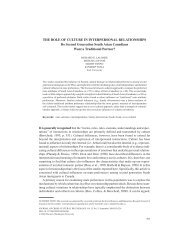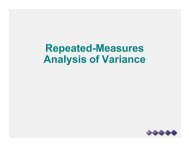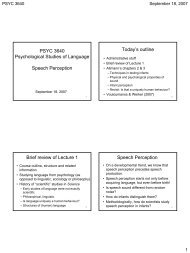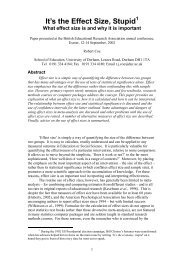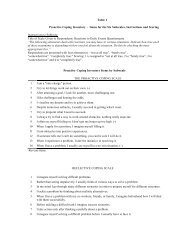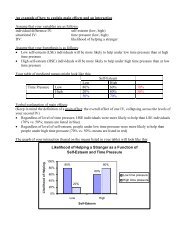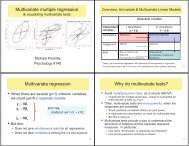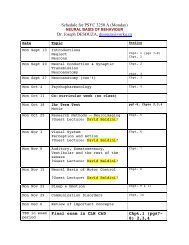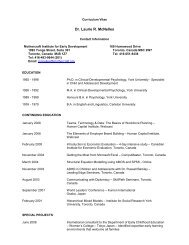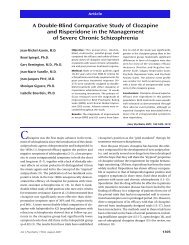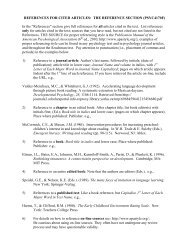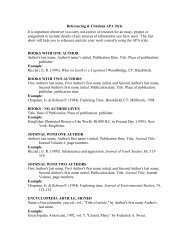Mapping sentence form onto meaning: The syntax–semantic interface
Mapping sentence form onto meaning: The syntax–semantic interface
Mapping sentence form onto meaning: The syntax–semantic interface
You also want an ePaper? Increase the reach of your titles
YUMPU automatically turns print PDFs into web optimized ePapers that Google loves.
have been examined in at least more than one language,<br />
namely subject–verb agreement and determiner–noun agreement.<br />
Those studies that focused on gender agreement<br />
between nouns and their corresponding determiner or their<br />
adjective do not always report LAN effects. It may not be<br />
surprising that gender agreement violations elicit less stable<br />
ERP effects because gender in<strong>form</strong>ation is part of the lexical<br />
entry and in some languages is phonologically constrained<br />
by the lexical <strong>form</strong> of the noun (in Spanish) while in others<br />
this is largely not the case (in French). In Spanish, LANs<br />
(Carreiras et al., 2004) or P600s (Barber et al., 2004) were<br />
observed, whereas in Dutch (Hagoort and Brown, 1999; Van<br />
Berkum et al., 2000) and in French (Foucart and Frenck-<br />
Mestre, 2004) P600s were found.<br />
For subject–verb agreement violations, stable ERP effects<br />
across different languages with strong inflectional morphology<br />
have been reported. Violations of number agreement<br />
between subject–noun and verb elicited a LAN in German<br />
(Penke et al., 1997) and in Italian (Angrilli et al., 2002;<br />
DeVincenzi et al., 2003). In another German study in which<br />
no LAN effect was found (Münte et al., 1997), the crucial<br />
<strong>sentence</strong>s did not contain outright violations but were<br />
obscured by a lexical ambiguity of the subject pronoun (sie<br />
which is ambiguous in number she/they). <strong>The</strong>refore, these<br />
findings do not challenge the argument that, in languages in<br />
which inflectional morphology (i.e. subject–verb agreement) is<br />
relevant for the assignment of grammatical roles, a LAN is<br />
observed. <strong>The</strong> latter view is corroborated by a study conducted<br />
in Hebrew, a language with noun–verb agreement in which<br />
noun gender agreement is relevant for the assignment of<br />
grammatical roles (Deutsch and Bentin, 2001). In this study, as<br />
expected based on relevance of this in<strong>form</strong>ation for grammatical<br />
role assignment, a clear LAN effect was found for gender<br />
agreement violation between the noun and the verb.<br />
Thus, LAN effects appear observable in languages in which<br />
the identification of grammatical relations depends upon the<br />
subject–verb agreement as signaled either by number, person<br />
and/or gender features. 2<br />
3.2. Processing in<strong>form</strong>ation of argument nouns<br />
<strong>The</strong> grammatical relations between a verb and its arguments<br />
in languages with free word order, such as German or<br />
Japanese, are not only marked by the verb’s inflection but<br />
moreover by the noun phrase’s inflection in the <strong>form</strong> of case<br />
marking.<br />
2 Tense agreement between the main verb and its auxiliary also<br />
seems to elicit LAN effects. This was observed for German<br />
(Friederici et al., 1993) in Dutch (Gunter et al., 1997) and in English<br />
(Osterhout and Nicol, 1999). Another study, however, in English<br />
using tense violations to test for grammatical violations (*has<br />
catch/has caught) did not find LAN (Kemmer and Kutas, 2006). In<br />
this latter study, the absence of a LAN could be due to the fact<br />
that the material used is ambiguous as the word has can be read<br />
as a main verb (e.g., he has fish in his box) and the word catch can be<br />
read as a noun. This interpretation is supported by Friederici et al.<br />
(1996) who demonstrated that an ELAN was only observed for<br />
outright violations, but not for ambiguous constructions where<br />
the crucial element could either be an auxiliary (wurde/was) or a<br />
main verb (wurde/became).<br />
B R A I N R E S E A R C H 1 1 4 6 ( 2 0 0 7 ) 5 0 – 5 8<br />
When reviewing the relevant literature, it seems that<br />
violations of the verb’s argument structure and its arguments<br />
either lead to a LAN or to an N400 depending on the language,<br />
and within a given language depending on the type of<br />
violation between the verb and its arguments in a <strong>sentence</strong>.<br />
When considering a verb’s argument structure, it is important<br />
to recognize that there are two ways it can be violated. A<br />
violation can be realized as a mismatch between the number<br />
of available arguments and those required by the verb or as a<br />
mismatch between the case marking of a given argument and<br />
that required by the verb.<br />
For German verb argument structure violations, such as<br />
Der Mann wurde geweint/<strong>The</strong> man was cried, in which an<br />
intransitive verb was presented in a passive structure requiring<br />
a transitive verb, a LAN was seen at the verb (Rösler et al.,<br />
1993). A LAN/P600 was found at the <strong>sentence</strong>’s final verb when<br />
the case of the actual object–argument (accusative) violated<br />
the verb’s argument structure (requiring a dative marked<br />
object argument), but an N400/P600 pattern was found when<br />
thematic assignment was impossible due to a mismatch<br />
between the already encountered number of arguments<br />
(three) and the number of arguments required by the verb<br />
(two) (Friederici and Frisch, 2000).<strong>The</strong>se different patterns<br />
were taken to reflect different aspects of verb argument<br />
structure. <strong>The</strong> N400/P600 pattern, in particular, was related<br />
to the fact that given the mismatch between the already<br />
perceived number of arguments (three) and the number of<br />
arguments the verb allowed (two) not only the grammatical<br />
roles, but also the thematic/semantic roles of the arguments<br />
could not be assigned. In a German study in which the two<br />
arguments of a verb carried nominative case (Frisch and<br />
Schlesewsky 2001), rendering the assignment of thematic<br />
roles impossible, an N400 followed by a P600 was also<br />
observed.<br />
In English, a language with fixed word order, case marking<br />
violations such as *<strong>The</strong> plane took we to paradise/<strong>The</strong> plane took<br />
us to paradise in which there is a mismatch between the case<br />
of the pronoun we, i.e. nominative, reserved to subjects, and<br />
its postverbal position which in a non-interrogative clause is<br />
reserved for objects, and object case, elicited a LAN (Coulson<br />
etal.,1998). Notice that in German, a free word order language,<br />
a P600 was found for a double subject structure (Frisch and<br />
Schlesewsky, 2001).<br />
A recent model by Schlesewsky and Bornkessel (2004) pays<br />
credit to these findings in that it assumes two parallel<br />
processing routes during Phase 2 of language processing: a<br />
thematic route which considers case and when marked<br />
unambiguously can map thematic roles directly and a<br />
syntactic route which is used for ambiguously marked arguments<br />
considering syntactic in<strong>form</strong>ation (e.g., word order or<br />
subject–verb agreement) instead. This latter route is generally<br />
used for languages without case marking.<br />
3.3. Processing verbs’ selectional restriction in<strong>form</strong>ation<br />
<strong>The</strong> processing of the selectional restriction violation of verbs<br />
has been studied in numerous studies across different<br />
languages. <strong>The</strong> violation of a verb’s selectional restriction<br />
elicits an N400 effect (e.g., Friederici et al., 1993). Because the<br />
N400 as a reflex of a semantic mismatch between the verb and<br />
53



